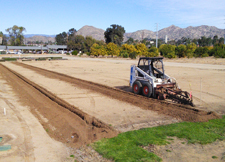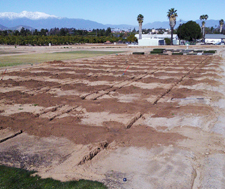Remote sensing of turfgrass response to irrigation strategies
Summary:
The western U.S. is generally arid and subject to droughts. At the same time, it is home to many large cities, which makes urban irrigation management a key component of any water conservation plan. During times of drought, in particular, it is crucial to develop irrigation strategies to keep landscapes alive with minimal water while also sustaining desired landscape quality. Turfgrass is a large component of urban landscapes and provides valuable recreation areas and ecosystem services. This project helped us determine the best irrigation strategies on two common turfgrass species using soil moisture sensors, smartphone-attached thermal cameras, and handheld optical sensors. This results are helping guide turf irrigation water conservation strategies to keep plants alive and sustain desired quality with minimum water.
Investigator:
Amir Haghverdi
Assistant Cooperative Extension Specialist
Department of Environmental Sciences
University of California, Riverside
Project description:
California’s recent, prolonged drought underscores the need to prioritize efficient landscape irrigation in urban areas. Research indicates up to half of the water used in urban landscapes is wasted due to over irrigation, poor distribution, inefficiency, and broken or poorly maintained irrigation systems. Significant water savings have been reported as a result of implementing technologies for landscape irrigation management. It is crucial to measure the impacts of strategies that reduce water waste and improve plant quality.
There are promising reports in the literature regarding the use of remote sensing techniques to monitor crop stress and enhance irrigation management. Recent advancements in thermal imaging using smartphone-attached cameras and affordable handheld devices may provide an opportunity for widespread adoption of remote sensing based techniques for urban water conservation and landscape irrigation management. Turfgrass in particular is worth monitoring because it is a large component of urbanized land area. Beyond recreational use, turf provides valuable ecosystem services including carbon sequestration and dust and noise reduction.
Our team monitored the effectiveness of remote sensing devices to detect and measure drought injury to bermudagrass and buffalograss turfgrass. We monitored turf response to multiple levels of water stress under drought conditions. In addition, we monitored the temporal changes in soil water status within the crop effective root zone under different irrigation treatments using soil moisture sensors.
This project helped to guide turf irrigation water conservation strategies to keep plants alive and sustain desired quality with minimum water. The findings of this research also added valuable insight into the efficacy of using emerging smartphone-attached remote sensing technologies for sustainable urban water management.


